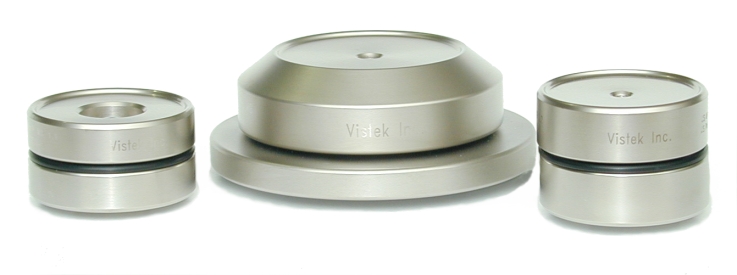- AUDIO ONE-TO-ONE Call Now: 210-805-9927
- Contact
- Register
- My Account
A BRIEF SURVEY OF ISOLATION DEVICES
It’s unquestioned that vibration and resonance alter the sound of our playback systems. How to deal with the problem though, is a topic of unusual complexity. A myriad of variables combine and interact to make the equation particularly convoluted. Influences include: source of vibration (structure-borne or air-borne), equipment support (nature of rack or stand), and sensitivity of the components to the vibrations present and the ability of the listener to perceive the effects of these variables. Include the most important and subjective, ones own personal preference, and we have an equation with no universal solution.
With such disparity among systems, environments and listening preferences, how can a comprehensive, tell-all review be written? It can’t. That’s why this treatise is labeled a survey, rather than a review. The information offered here is but a general overview and should be considered a starting point, rather than an endpoint.
Most of you have experimented with isolation; be it cones, spikes, bearings, isolation platforms and bases or one of the many viscoelastic feet. They all change the sound. Which one is best, depends on the variables we’ve previously noted, as well as (and certainly the most important constituent) our own personal preferences. An example: device “A” offers a slightly warmer flavor while device “B” results in a faster or brighter sound. Which is right will depend on your inclination and how your system is tuned. Now, I’m not saying that all isolation devices affect tonality, but the same analogy would apply to other characteristics of the device employed (detail, leading edge transients, ambience retrieval, etc.).
System variables not withstanding, I’ve found that most all devices have a general thumbprint, a basic character apparent in nearly all systems. Many fine points will vary, of course, but I’ve had enough experience with the offerings (both in my systems and feedback from countless clients) to feel comfortable generalizing.
Lastly, I’m neither disputing nor endorsing the concepts or theories behind any of the products. I have no training as a mechanical engineer or physicist; I’m simply a careful listener. I do know there are as many questions as answers in this arena, with each manufacturer asserting the validity of their particular designs. So, like with any other product in audio, let your ears be the judge. I’ll offer another caveat. While I have evaluated all the products listed here, I cannot say that I am familiar with every offering in every line. Further, there may have been changes or additions since my last experience. Again, use this not as an absolute reference, but as an overview to familiarize yourself with available offerings. Always consult a knowledgeable dealer for specific recommendations that suit your system and preferences.
Data is provided in tabular form for easy cross referencing. To keep the survey brief, I’ll offer a basic thumbnail sketch of each product (though I could write pages on each describing intricacies I’ve experienced, most of that knowledge is specific to my system). Next, I’ll "grade" each product on several scales. I’m trying to stay very objective with these, using mainly feedback that I’ve received from the field.
In the performance field note than some products are tagged with a plus or minus symbol. The “+” indicates a product works well in most systems, “-“ means the item is system dependant, either because of strongly variable performance or mechanical considerations (e.g. too tall to fit in most racks).
Products have been divided into five categories, describing their approach: Viscoelastic (soft resilient feet), Rigid (usually cones of various materials), Roller Ball (devices utilizing ball bearings in some way), Bases (platforms of any sort) and Other (either using multiple technologies or not fitting into any category listed above). Products are assessed using a scale of 1 – 10, ten being best. The "ratings" are based on feedback from customers.
All items are listed in alphabetical order and not in any sort of preferential ranking.
Comparison Chart -
|
Product |
Class |
Material |
Price |
Value |
Performance |
|
Aurios Classic * |
Roller Ball |
Stainless |
$199/3 |
8 |
8 |
|
" Pro Max * |
Roller Ball |
Stainless |
$349/3 |
7 |
8 |
|
“ Decouplers * |
Roller Ball |
Stainless |
$60/3 |
7 |
7 |
|
Black Diamond Racing Cones |
Rigid |
Carbon Fiber |
$60/3 |
7 |
5 |
|
Bright Star Big Rock |
Base/Other |
Various |
$299 |
5 |
4 |
|
“ Gemini |
Base/Other |
Various |
$325 |
5 |
5 |
|
“ Air Mass |
Base/Other |
Various |
$399 |
5 |
5 |
|
“ Iso Node |
Viscoelastic |
Elastomer |
$12.50/4 |
7 |
3 |
|
Clear Audio Magix |
Other |
Various |
$200ea |
2 |
8 |
|
Daruma IIIi |
Roller Ball |
Aluminum |
$99, set of 3 |
7 |
5 |
|
DH Cones – Large |
Rigid |
Ceramic |
$60, set of 3 |
9 |
7+ |
|
“ Jumbo |
Rigid |
Ceramic |
$90, set of 3 |
9 |
7+ |
|
“ Super |
Rigid |
Ceramic |
$120 set of 3 |
8 |
7+ |
|
FIM Platform * |
Wood, Roller Ball |
Various |
Not currently available |
7 |
8 |
|
“Isolation Bearings |
Roller Ball |
Various |
$159, set of 3 |
8 |
7+ |
| Finite Elemente * Ceraball Universal |
Roller Ball/Other |
Aluminum and Ceramic (bearings) |
$175, set of 3 |
8 |
7+ |
| " Cerapuc |
Roller Ball/Other |
Stainless and Ceramic (bearings) |
$390, set of 3 |
7 |
8 |
| " Cerabase |
Roller Ball/Other |
Stainless and Ceramic (bearings) |
$690, set of 3 |
6 |
8 |
| Gingko Mini Clouds |
Viscoelastic |
Plexiglas and rubber |
$99, set of 3 |
7 |
8 |
| " Isolation Bases |
Viscoelastic |
Plexiglas and rubber |
$299 and up |
7 |
8 |
|
Marigo Small Cones |
Rigid |
Composite |
$95, set of 3 |
7 |
7 |
|
“ Signature Cones/Base |
Rigid |
Composite |
$239 |
4 |
4 |
|
“ Reference |
Rigid |
Composite |
$150/3 |
7 |
6 |
|
S.A.P. Relaxa Base |
Other |
Various |
$795 |
3 |
7 |
| Silent Running Audio Isolation Bases |
Constrained Layer |
Various |
$1000 and up |
4 |
8 |
|
Stillpoints |
Other |
Various |
$150 ea and up |
8 |
9+ |
| " Component Stand |
Other |
Various |
$899 and up |
6 |
8 |
|
Symposium Rollerblocks 2+ |
Roller Ball |
Stainless and Tungsten (bearings) |
$399, set of 3 |
8+ |
8+ |
| Symposium Rollerblocks Jr. |
Roller Ball |
6061 Aluminum and Stainless (bearings) |
$219, set of 3 |
9 |
8 |
| " Svelte Platform |
Constrained Layer |
Stainless, other |
$199 and up |
8+ |
8 |
| " Ultra Platform |
Constrained Layer |
Stainless, other |
$399 and up |
8+ |
8 |
| Townshend Seismic Sink * |
Base/Other |
Metal |
$300 + |
4 |
5 |
|
Van Slyke Engineering * |
Other |
Various |
$995 - $1595/3 |
2 |
4 |
|
Vibrapods |
Viscoelastic |
Elastomer |
$6ea |
8 |
2 |
|
" |
Other |
Various |
$8ea |
8 |
2 |
* Currently unavailable or out of production
Photos and descriptions -
Aurios - Media Isolation Bearings. Maker Vistek has wide-ranging expertise in solving vibration induced problems on an industrial and architectural scale. Since 1994, technologies developed by Vistek and its affiliates have been utilized in structures as varied as bridges, towers and clean rooms. Scaled down to meet the needs of audio, Vistek make use of their knowledge in the design of the Media Isolation Bearings. The Aurios contains three ball bearings in dimples or raceways inside the device. The bearings separate the top and bottom halves of the "sandwich," for a very low friction interface. The balls and the raceways are highly hardened and smoothened alloy, stainless, metal-glass or ceramic parts. Two products are offered, Pro Max and Classic. Optional decouplers (shown in photo above) are available that further enhance performance. Recent price decreases have added to the value of these devices.
Character: Exceptionally fast, open quality with excellent dynamics.
Pros: Relatively small, allowing their use under most components. Almost limitless weight bearing capacity.
Cons: Price. Rack should be level for optimum performance. The enhanced level of detail may prove overly analytical in some systems.
Dimensions: 2.0 - 5/8"H x 2"D 1.1 - 1.5”H x 1.5”D (not pictured) Pro – 1.75”H x 3”D (Not pictured)
Price: Classis - $199, set of 3, Pro Max - $349, set of 3, Decouplers - $60, set of three
Currently unavailable, consider an upgrade to Stillpoints
Black Diamond Racing – Carbon fiber cones. Materials science has found its way into the world of audio vibration devices. A good example is the BDR cones, made from carbon fiber, a very strong and very lightweight material. The company’s offerings include cones, platforms, pucks and a record weight. We’ll confine our survey to the cones. BDR offers two versions; Mark III and Mark IV.
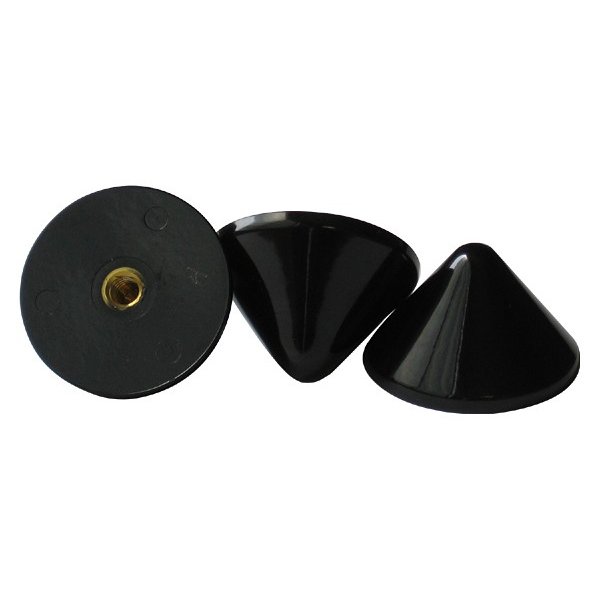
Character: The Mk III is a bit warmer, the Mk IV more extended.
Pros: Inexpensive. Short stature allows them to be use in a wide range of applications. Low cost.
Cons: Short stature may not raise components high enough to bypass existing feet.
Dimensions: .5” H x 1.5” D
Price: About $100, set of 3
Bright Star Audio: Bright Star was the first to use sand as an isolation material for audio equipment. Since then they’ve added pneumatic isolation and constrained-layer bases to their line. The company offers a wide range of products, in an array of sizes, depending on the application.
Sand can effectively store and dissipate vibrational energy. It has been used in other industries where damping vibration is needed.
Bright Star believes that mass loading components (adding weight) improves performance. Their Little Rock products are heavy, damped pods designed to be placed on top of components to damp the enclosure.

Pneumatic isolation platforms can effective in some systems, but their idiosyncrasies can be problematic. Leveling components with unevenly distributed weight can be difficult to impossible with single bladder designs. Multi bladder systems can compensate, but as the bladders loose air the problems returns. And all the designs I’ve tried air loose air pressure over time. Pneumatic bladder designs require regular checks for correct pressure
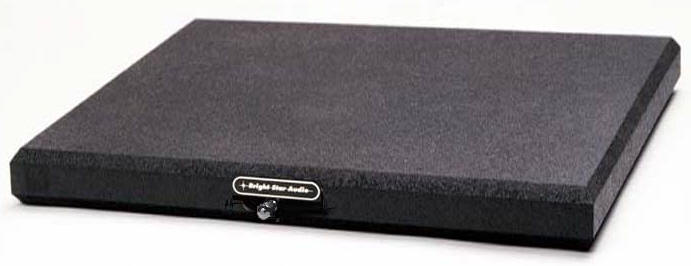
Character: Can smooth peaks in a bright or edgy system though some feel the sound is over damped.
Pros: Extra weight can help load the equipment stand.
Cons: Size may preclude their use if space is limited. When filled, the sand boxes can be very heavy and will spill if tipped.
Dimensions: Many sizes available
Price: About $200 to $500
Currently unavailable, consider an upgrade to the Symposium platforms
Clear Audio - Magix – Magnetic Isolation Pods. Such an interesting concept, that of magnetic levitation and one that has been tried many times over the years. The goal is to float a component on nothing but a magnetic field. Clearaudio Magix isolation pods have come as close as any to achieving the goal.
What does a component sound like floating on air? I’ve found the Magix enhance ambience, space and smoothness. I note a reduction in grain and grit resulting in a very refined and easy, almost soft quality. That said, some might miss the attack, speed or detail found in hard coupling feet, roller bearing designs or cones.
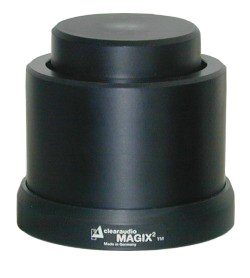
Character: Velvety smooth, airy.
Pros: Extreme decoupling.
Cons: Expensive. Tall, preventing their use in many applications. Expansive but somewhat diffused soundstage.
Notes: Each unit supports approximately 12 pounds. Divide the weight of your component by twelve to determine the number needed.
Dimensions: 4-1/4”Diameter x 3.3/4”H
Price:
Currently unavailable, consider an upgrade to Stillpoints
Daruma IIIi – Ball bearing isolators. Final Labs from Japan were the first to offer an inexpensive ball bearing device. The Daruma IIIi works well in many systems and as a result have enjoyed widespread popularity.
A stainless steel ball bearing separates top and bottom pucks made of aluminum. The aluminum is rather soft (in comparison to the stainless ball) and will gall under heavy loads. We do not recommend you not load the Daruma IIIi with components over 20 pounds.
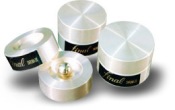
Character: Expect most of the speed, focus and detail found in similar ball bearing devices.
Pros: Inexpensive. Lacking the last ounce of clarity and resolution found in more expensive ball bearing devices.
Cons: Limited weight bearing capacity, easily damaged by heavy components. Somewhat tedious set up.
Dimensions: 1 – 3/4” Diameter x 2”H
Price: $99 set of 3
Currently unavailable, consider an upgrade to Stillpoints
DH Labs – Ceramic Cones. The material used in a coupling or decoupling device affects the "sound." Some designers feel cones should be made of the hardest material available. Following that belief, DH Labs has chosen ceramic - the hardest material available (next to diamond).
We've had generally good luck with the DH Labs cones. Their slightly blunted tips are not likely to mark most equipment shelves expect under very heavy loads.
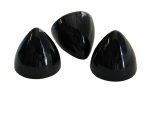
Character: Enhanced leading edge transient definition.
Pros: Lacks excessive brightness or stridency.
Cons: No major concerns.
Dimensions: Large – 1”H x 1.25”D, Jumbo – 1-3/8”H x 1-9/16”D, Super – 1.5”H x 1.5”D
Price: Jumbo $129, set of 3, Super $179, set of 3
Eraudio - Space Harmonizer – Not really an isolation base in the strictest sense, we should probably refer to the Eraudio as an equipment platform. The manufacturer states: “Harmonizer doesn’t absorb vibration, but redistributes its spectra towards higher naturalness and harmony for human ear”.
The Space Harmonizer is constructed using "tuned" resonant bars of Siberian Cedar assembled into (a rather lightweight) platform. It’s of laminated construction, similar to the way a cutting board is made.
The manufacturer recommends that four viscoelastic feet or steel cones (preferably their own design) be used beneath the platform, one located at each corner. Best results, according to Eraudio, are obtained when using the Space Harmonizer under speakers. In all fairness to the manufacturer, I was not able to test them effectively in that scenario. For me, the additional height of the platform and cones beneath the speaker changed the tonal balance of the speaker and made the results hard to interpret. My listening tests employed source components and electronics only.
I really did not find any significant effect when using the Space Harmonizer. The platform did add a subtle glow to the music, but it was indeed slight. The bases are rather attractive, and most gear did look nice perched atop a Space Harmonizer.
To be fair, the manufacturer does suggest that speakers benefit most, but as mentioned previously, they simply weren’t an option for me.

Character: Very subtle sense of added warmth.
Pros: Attractive.
Cons: Low perceived effect. The overall height is likely to become an issue when the requisite cones are added. Sizes are inappropriate for many U.S. components.
Dimensions: Small – 18.5”W x 11.5D x 1.5”H. Large – 24”W x 15”D x 1.5”H
Price: $249 - $349
First Impression Music - Isolation Platform and Isolation Stand. First Impression Music is respected for their superb CDs and SACDs. Proprietor Winston Ma is a recording engineer of great renown and a very dedicated audiophile. In assembling his own system, he found himself dissatisfied with much of the available offerings. This led him to design several products on his own; interconnects and speaker cables, an (outstanding) AC outlet and now three isolation products.
Many designers feel wood (particularly Maple) offers a certain richness that enhancers harmonic structure. It has become a popular material. Winston Ma felt that while Maple (Ebony was his first choice, but far too expensive) was a good basic material for a platform, on its own it did not fully address the issue of vibration and resonance control. His experiments led him to marry the richness of Maple with the speed of roller ball technology.
His roller bearing design is unique in regards to the choice of materials. The load bearing pucks are brass, coated with hardened white steel. A stainless steel or tungsten carbide bearing is employed. The pucks are recessed into the wood for intimate contact.
The Platform consists of a 1.75” selected hard rock Maple platform resting on three roller ball isolators and a lower MDF platform. It can be used under virtually any component and has a weight bearing capacity of 100 pounds.

Character: Doesn’t seem to affect tonality to any great degree, perhaps a touch of additional warmth in the mids.
Pros: Balance of qualities – enhanced leading-edge transients, improved resolution of low level detail.
Cons: May be too tall for some applications.
Dimensions: Platform - 19” W x 15” D x 2.75”H. Stand - 19” W x 15” D x 5.75”H.
Price: $298 - $438
Note: Sadly, Winston Ma has passed away and his products are no longer available
Currently unavailable, consider an upgrade to the Symposium platforms
First Impression Music Platinum Iso bearings – The Platinum Iso Bearings were not originally intended to be used alone, but rather offered as a kit for those who want to build their own platforms. However, our experimentation shows they can be used alone with excellent results. Clearly balanced toward a fast articulate quality, when compared with the FIM platforms, they offer similar performance characteristics to other roller bearing devices at a very reasonable price.

Character: Detail, speed, focus.
Pros: Low profile, lowest cost quality bearing isolators
Cons: Mechanical resistance from cables should be addressed.
Dimensions: 1-5/8” diameter x 7/8” H
Price: $185, set of 3
Note: Mr. Winston Ma has passed away and the products are no longer available
Currently unavailable, consider an upgrade to the Symposium platforms
Finite Elemente: The latest addition to the ceramic isolation devices is the Ceraball Universal. This all new design is a much improved version of its predecessor, offering a larger surface area for better contact with the component for improved performance.
Aluminum is used for the housing, the ball bearing is ceramic.
The Ceraball Universal, as its name suggests, can be used in a wide range of applications from source components all the way through the signal chain to the loudspeakers. With speakers in mind, Finite Element includes threaded studs (6mm and 8mm) for coupling to the spike inserts on the bottom of your speakers. A set of 3 Ceraball Universal isolators can handle up to 300 pounds, for pucks support 350.
Also available are Cerapuc and Cerabase. These offer better performance through the use of stainless steel and further design enhancements. Cerapuc and Cerabase also offer higher weight bearing capacities for very heavy speakers and racks.
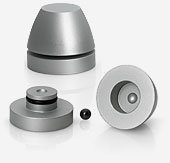
Character: Detail, speed, focus.
Pros: Work with many different components. Very high weight bearing capacity.
Cons: Can be expensive
Dimensions: 1.4” diameter x 1.2” H
Price: $175, set of 3. Four pack $229
No longer available, consider an upgrade to Stillpoints
Gingko - In the Gingko designs, isolation from structure-borne vibration is accomplished through the use of viscoelastic balls sandwiched between two pieces of Plexiglas. Each ball supports up to a maximum of 12 pounds, and one chooses the number required for the application.
We've found the Gingko platforms to be effective in a number of applications using a wide range of equipment. They have proven particularly effective under turntables as well as CD players and tube gear. Our experiments here using the VPI Scout and Scoutmaster returned impressive results by dramatically lowering the noise floor.
We believe the most successful designs for use under turntables will be those with the ability to provide low frequency isolation (SAP Relaxa and Magix share this category with Gingko).
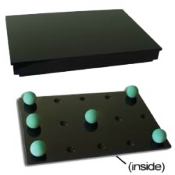
Lighter turmtables can be accommodated by the Cloud 14 Series which employ a pre-weighted and damped upper platform. These optimize performance by correctly pre-loading the viscoelastic balls allowing lighter weight turntables (e.g. Rega).
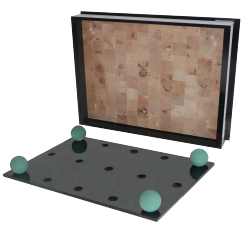
Character: Neutral to softening or warming
Pros: Adaptable to a broad range of equipment
Cons: Add a few inches of height to the component so be sure you have enough space above
Dimensions: A number of sizes are offered. The Model 10 pictures measures 18"W x 14"D x 2.5"H. Custom sizes are available; call for pricing
Price: $299 and up
Marigo – Orpheus E3 Isolation Feet are designed for use with electronics, including tube amplifiers, solid state amplifiers, tube preamplifiers, solid state preamplifiers, digital transports and players, digital to analog converters, servers, phono stages, turntables, power conditioners, and under speakers and equipment racks.
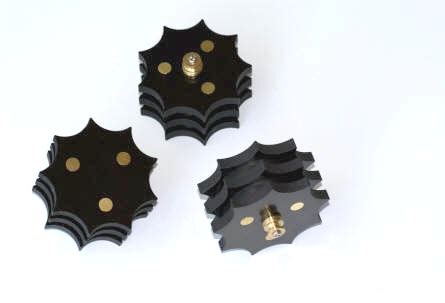
Character: Variable depending on model
Pros: Small – Inexpensive. Large – Reasonably priced.
Cons: Small – Height may become an issue. Large w/bases – Strong character (often very bright) makes them very system specific.
Dimensions: Small - 1.5"H x 1.25"D Large – 2”H x 1.75”D
Price: $1199, set of 3
Polycrystal Isolators– The modest cost and worthwhile improvements make the Polycrystal Isolators a good value but inconsistent availability have made DH Labs cones (and to some extent the Marigo offerings) more popular. Polycrystal Isolators generally do not change tonality in most systems.
Two sizes are available, Standard and Reference. The Reference may be better in some systems, but on balance, I feel the Standard size is the better value.
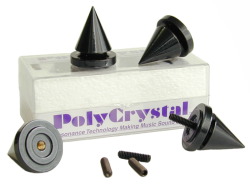
Character: Enhanced leading edge transient definition.
Pros: Inexpensive. Balanced performance. Works well in most systems.
Cons: No major concerns.
Dimensions: Standard - 1”H x 1.25”H, Reference – 1-3/8”H x 1.5”D
Price: $65, set of 3, Reference $150
No longer available, consider an upgrade to Stillpoints
SAP: Relaxa Isolation Base – The Relaxa employs magnetic levitation (see Clear Audio Magix) to isolate the top platform from the base below. A tempered glass top plate floats on three magnetic pistons (adjustable for leveling).
The Relaxa is an excellent performer in most applications.
Weight bearing capacity about 50 pounds, though a fifth piston assembly can be added to increase carrying ability to approximately 65 pounds. Sensitivity to unevenly weighted components should be noted.

Character: Doesn’t seem to affect tonality to any great degree. Airy, liquid, refined.
Pros: Balanced performance. Works well in most systems. Stylish.
Cons: Price. Fixed weight bearing capacity. May require off center placement of components with uneven weight distribution. Overall height may be an issue in some systems with limited space above the component to be isolated.
Dimensions: 21.6”W x 16.6”D x 1-3/4”H.
Price: $795
No longer, consider an upgrade to Symposium or Ginko Isolation Platforms
Silent Running - Isolation Bases. Proprietor Kevin Tellekamp leads a dual life. Part of the time he works on exotic military applications including work on silencing nuclear submarines. The term used for an operationally quiet stealthy sub is "silent running," and has become the moniker for the company. The half of his life as an audiophile revolves around making isolation products for audio gear.
Kevin has also been a consultant to several high end audio companies to address chassis vibration and resonance.
His designs are custom made for an individual component. Taking into consideration total weight and weight distribution, he formulates various durometer absorptive foams to quell vibration.

Character: Doesn’t seem to affect tonality to any great degree.
Pros: Balanced performance. Works well in most systems.
Cons: Expensive. Must be specifically engineered for a given component and far less effective if used with another piece of gear.
Price: $1000 and up
Stillpoints – Developed by a former Wadia employee and the previous distributor of Aurios bearings, the Stillpoints are a totally unique, sophisticated and effective design.
The latest products from Stillpoints, the Ultra Series, represent a quantum leap in performance over Original Stillpoints.
Inside the Ultra Series devices are five pockets of the Company’s patented vibration absorption technology, compared to just a single pocket in the Original. This new design offers a remarkable level of sonic enhancement that allows your system to perform at a level you never dreamed possible.
Stillpoints offer three isolation footers, with performance improving at each level. As the name suggests, the Ultra Mini SS is a more petite version of the Ultra SS. Also made from stainless steel, the Ultra Mini features the same incredibly effective, patented energy absorbing technology found in other Stillpoints products. Ultra Mini is ideal for use under most components (but not recommended under large loudspeakers) or where budget is a concern. Recommended for speakers or components of 55 pounds or less.
The next step up is the Ultra SS. This model uses a more sophisticated isolation array and the greater mass of the larger stainless steel body offers enhanced performance as well. The Ultra SS is the most popular model in the line.
The Ultra 5 is designed for use with speakers. Their weight-bearing capacity is prodigeous, so even very large, heavy speakers can be accommodated.
The top of the line is represented by the Ultra 6. This massive device offers the highest level of isolation and vibration absorption in line. The Ultra 6 can be used with most any component.
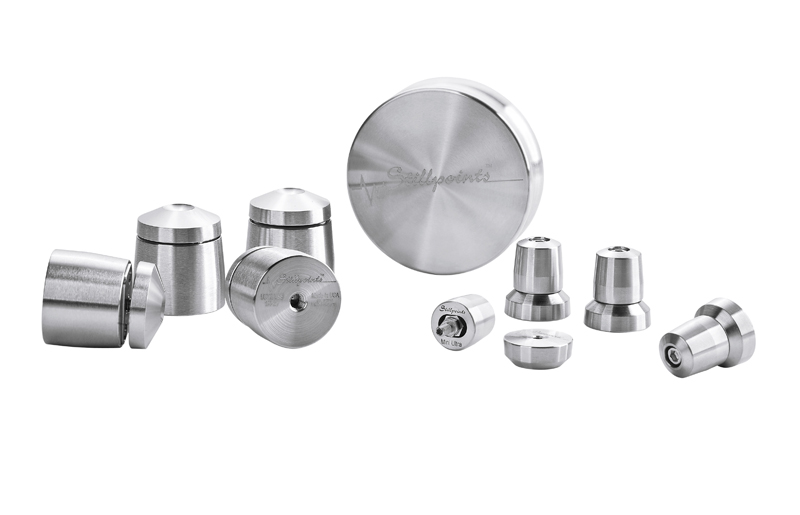
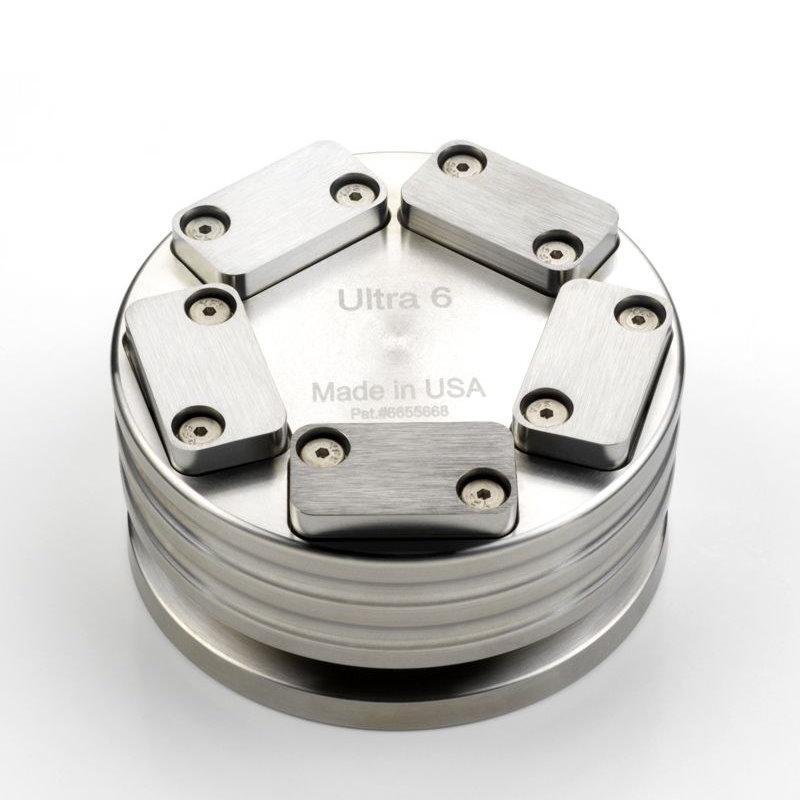
Ultra 6
Character: Tonal character lies somewhere between the extremely fast qualities of ball bearing devices and that of composite and ceramic cones.
Pros: Relatively small. Can be used with a threaded stud insert for tight coupling to a component or loudspeaker with threaded inserts. Works predictably in virtually any system with any component or speaker.
Cons: Price
Dimensions: Ultra Mini - 1.25" H x 1" Diameter
Ultra SS - 1.8" H x 1.25" Diameter
Ultra 5 - 2.25" H x 3" Diameter
Price: Mini - $150 each, Ultra SS - $299 each, Ultra 5 - $839 each, Ultra 6 - $1137 each w/base, LPI Record Weight - $659
Stillpoints ESS Rack - Stillpoints applies their isolation technology to a full rack. The stands come in shelf widths of 20″ or 26″ or 40″ and can accommodate any number of shelves to suit the application. Though pricey, we find the Stillpoints ESS rancks and stands to offer exceptional performance and used by a number of prominent audio reviewers.
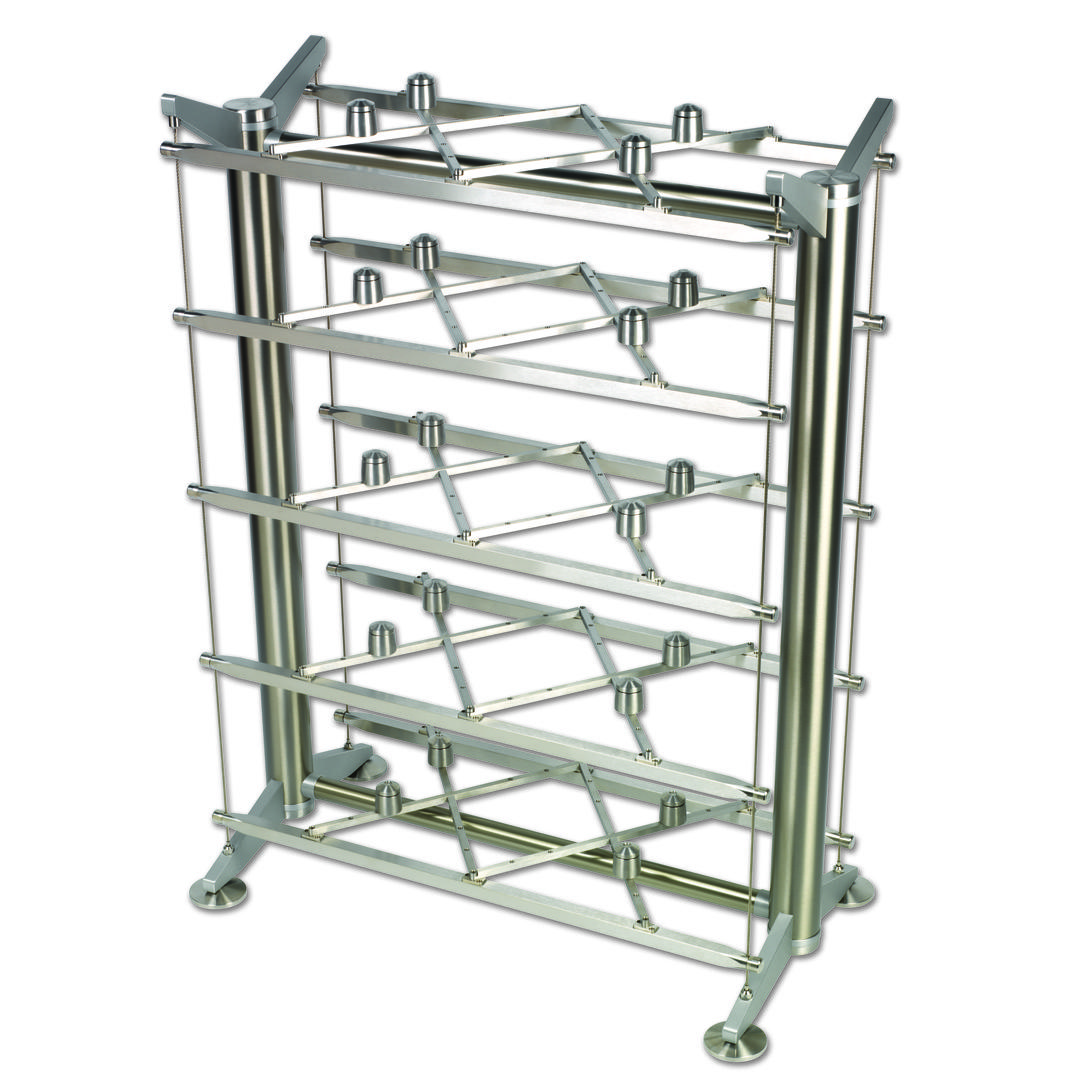
Character: Tonal character is neutral.
Pros: Extremely effective, cosmetically attractive.
Cons: Price
Dimensions: Varies
Price: $8000+
Symposium - Rollerblocks – The original purveyor of ball bearing technology this company have offered products employing ball bearing isolation methods since 1997. A In the design, a concave dish has been mounted in block of special isolating material. A ball bearing (stainless or tungsten) rests in the dish and the component on top of the bearing.
The latest version is the 2+ and has been favorably reviewed by Soundstage! and Enjoy The Music.
A less expensive offering, the Rollerblock Jr., offers about 70% -80% of the performance found in the Rollerblock 2+.
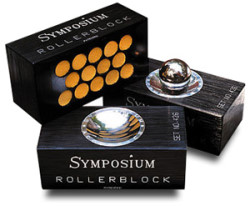
In addition to Roller Blocks, Symposium offers a range of component platforms that employ sophisticated constrained-layer damping techniques techniques.
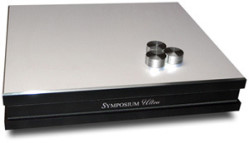
Character: Expect the speed, focus and detail found in similar ball bearing devices
Pros: Relatively small size.
Cons: All with all ball bearing designs, optimum results when the equipment rack is level and stresses exerted by connecting cables have been relieved. Price.
Dimensions: Roller Block – 2” W x 1” W x 1.25” H
Price: Rollerblock 2+ $549+, set of 3
Price: Rollerblock Jr. $349+, set of 3
Price: Rollerblock Jr. HDSE - $449+, set of 3
Price: Bases - Stealth - $139 and up (depending on size), Segue $199 and up (depending on size), Segue Iso - $449 and up (depending on size), Ultra $399 and up (depending on size)
Townshend Audio: Max Townsend of Britain popularized the use of pneumatic isolation bases for audio applications. His line of Seismic Sinks originally used an inflatable internal bladder (or multiple bladders) separating a top and bottom plate of damped metal. While the design had merit, the bladder would slowly loose air pressure over time, which changed the resonant frequency and performance was lost. A valve permits inflation with a bicycle pump. Very low pressure is maintained in the bladder, just enough to separate the top and bottom panels; the less pressure, the lower the resonant frequency.
Pneumatic isolation platforms can effective in some systems, but their idiosyncrasies can be problematic. Leveling components with unevenly distributed weight can be difficult to impossible with single bladder designs. Multi bladder systems can compensate, but as the bladders loose air the problems returns. And all the designs I’ve tried air loose air pressure over time. Pneumatic bladder designs require regular checks for correct pressure.
We understand that the latest Townshend Seismic Sinks have substituted springs for the air bladder, but we have not had the opportunity to hear the new designs.

Character: Reduced background haze, may subtly shift tonal balance to the warm side.
Pros: Isolates in both horizontal and vertical planes.
Cons: Somewhat costly, the height of the platforms may preclude their use where space is limited.
Dimensions: 17”W x 13”D to 27”W x 14”D
Prices: $300+
Van Slyke Engineering Tri-Orb – Unique and rather complex devices using a multifaceted combination of cones, roller-balls, sling suspenders, decoupled spring-mass absorber blocks, cork & gray felt layers, and Neoprene O-ring sling suspension.
Our brief experience found set up to be exceptionally involved and I'm not sure we ever realized the full potential of the devices. They may be good performers, but the cost and extreme difficulty of setup reduce their appeal to all but the most committed audiophiles.
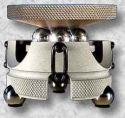
Character: Varies depending on system. They were a bit bright here.
Pros: Tune-able
Cons: Expensive, tedious setup, height.
Dimensions: Depends on model
Price: $995 - $1595, set of 3
Vibrapods: Most of the soft damping feet are a simple chunk of viscoelastic material. Vibrapod molds a vinyl-based damping material into a unique shape, said to be more effective at reducing vibration than simpler designs.
Five versions are available, each with different weight bearing capacities. Choose based on the amount of weight you need to support.
The Vibrapod’s have been well accepted by our clients with modest systems. They also seem to perform well under most video gear. As the resolution of the system improves the value of the product diminishes. High resolution systems will likely experience some blurring of images, softening of focus and dulling of the tonal balance.
Character: tonal balance, somewhat diffused sound field.
Pros: Very inexpensive. Short height allows their use in most any situation.
Cons: Leaves oily residue that may be impossible to remove (we recommend a circle of plastic wrap or wax paper be used above and below each Vibrapod). Will likely flatten over time (especially if loaded to maximum weight).
Notes: Always use a circle of plastic wrap above and below each foot as they are apt to leave a permanent mark.
Dimensions: 9/16”H x 2.5”D
Price: $6 each

Vibracones – The same viscoelastic material found in Vibrapods fashioned into a cone shape with a stainless steel ball bearing inserted at the tip. Weight bearing capacity between 6 and 10 pounds. Use the number needed to support the weight of your component. Vibracones can be stacked on Vibrapods for additional isolation.

Character: Similar to Vibrapods but with increased focus.
Pros: Very inexpensive.
Cons: Leaves oily residue that may be impossible to remove (we recommend a circle of plastic wrap of wax paper be used above each Vibracone).
Dimensions: 1"H x 1-5/8"D
Price: $8 each
Notes: This is an ongoing survey. It will updated on an irregular basis with new information, changes to existing products and the addition of new offerings. Be sure to check back on occasion.


